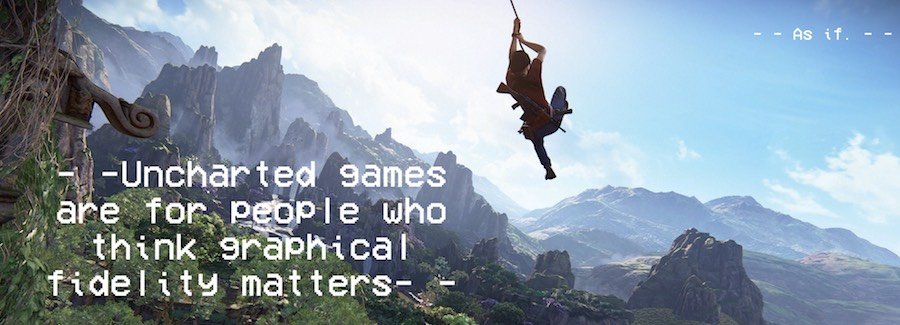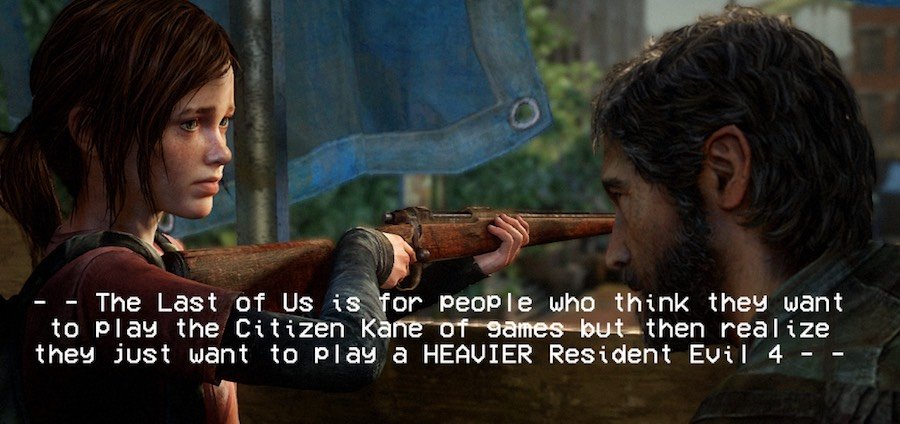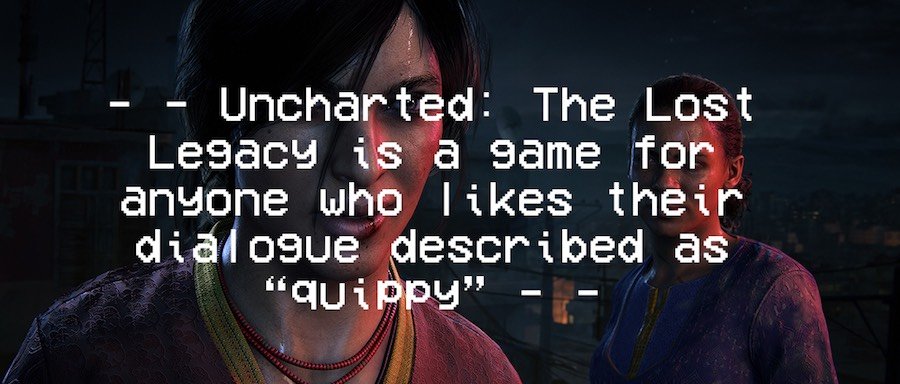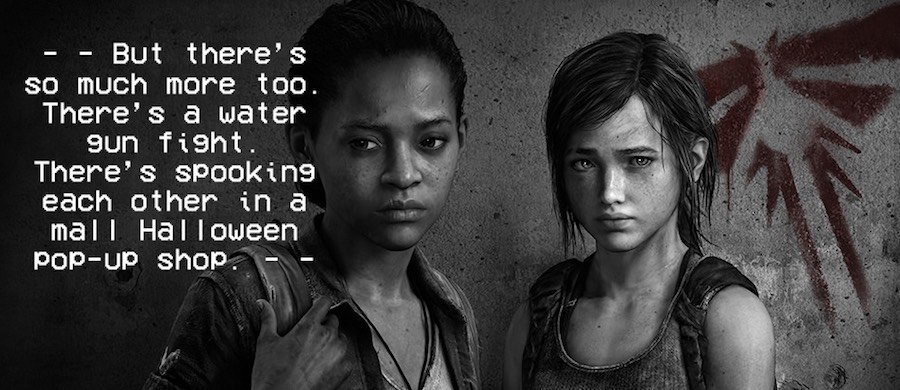
There is a time and a place for Uncharted video games; it’s somewhere between 2001 and 2010. Americans needed escapism, heroic gunfights, and they could be forgiven for seeing exotic locales as playgrounds. Naughty Dog’s Uncharted: Drake’s Fortune (2007) was an exercise in Indiana Jones fan fiction and photo-realism. The follow-up, Uncharted 2: Among Thieves (2009) is generally regarded as the pinnacle of the series. A rare sophomore effort that outstrips the first project without over-reaching. Uncharted 3: Drake’s Deception (2011) was a lot like Among Thieves but somehow dumb, boring, and poorly titled.
Then, from the same studio, came The Last of Us (2013), an astounding video game. Serious, clever, grounded, powerful - a game that probably made Naughty Dog finally feel weird about being called Naughty Dog. The Last of Us was Uncharted with a tight camera, an appropriate feeling of wonder brought on by the contrast of desperation, and guns that felt like guns.
What is the Uncharted series
There are four canonical Uncharted titles, for the Playstation 3 and Playstation 4, all developed by Naughty Dog. In each, you play as Nathan Drake, inveterate treasure hunter and adventurer. As Nathan, you shoot and climb your way through environments in Scotland, Tibet, Istanbul, Borneo, the Amazon, etc. Shooting and climbing are broken up by filmically adept cut scenes. The Uncharted series is seen as a benchmark for animation and environmental graphics, not just in console gaming but across the industry.
Uncharted games are for people who know graphical fidelity matters.
Uncharted games are for people who think graphical fidelity matters.
What is The Last of Us?
Developed concurrently with Uncharted 3, Naughty Dog’s The Last of Us is a third-person action-adventure video game with survival elements. It was published in summer 2013 to immense critical and consumer acclaim, provided you had a Sony Playstation 3 and were thus paying attention to that sort of thing.
In The Last of Us you (mostly) play as Joel, a man living in a post-apocalyptic world, fighting fungal zombies and murderous scavengers. Mankind is at its worst. Joel gets saddled with escorting 14-year-old Ellie through the country - initially for selfish reasons, later because of father-daughter dynamics and the fact that hope springs eternal in the yada yada yada.
The Last of Us feels good to play, especially during the parts that count. Combat is heavy and brutal. Shooting is heavy and brutal. Walking is heavy. Falling is heavy. The feelings are even heavy, thanks to some stellar acting and actual script restraint.
The Last of Us is for people who think they want to play the Citizen Kane of games but then realize they just want to play a HEAVIER Resident Evil 4.
At the same time, The Last of Us is for gamers who want to demonstrate to someone that a video game can make you weep.
The Last of Us was and remains a pinnacle of the most basic and familiar tenets of third-person shooter game design. It also blew perceptions of video game storytelling out of the water. Just as most of us were feeling justified in positing that games couldn’t ape filmic storytelling, The Last of Us demonstrated otherwise. While there’s no particularly clever marriage of design and narrative in The Last of Us, it is so accomplished in both areas, and meshes them so cleanly, that despite the constant specter of ludo-narrative dissonance it all works.
The Last of Us was co-directed by Bruce Straley and Neil Druckman. But this review isn’t about The Last of Us or even Straley and Druckman’s next game, Uncharted 4: A Thief’s End. It’s about that game’s spin-off, Uncharted: The Lost Legacy. Over which a large Cormac McCarthy-shaped shadow looms.
What is Uncharted: The Lost Legacy?
A sequel/spin-off to Uncharted 4: A Thief’s End, Uncharted: The Lost Legacy really milks the singular and non-specific article “A” from 4’s subtitle. While Nathan Drake’s adventures have ended, there’s plenty more Thieves to stand in.
Lost Legacy was developed by Naughty Dog and published by Sony for the Sony Playstation 4, exclusively, in August 2017. You play as Chloe Frazer, a treasure hunter, accompanied by Nadine Ross, a former-mercenary, in search of the Tusk of Ganesh, a legendary Hindu relic of some sort - it doesn’t really matter much. Over the course of your adventures in India, you’ll shoot bad guys with guns, swing on ropes, climb a lot of stuff, solve mechanical puzzles, cliff-hang, slide, punch, leap, crack wise, etc. etc. This is the embodiment of “Adventure” as a genre.
Directed by first-timers Shaun Escayg and Kurt Margenau, Lost Legacy is easily described as an iconic song performed by a new band that people will debate endlessly - “Is the cover better than the original?” - without asking whether the original song was really that great to begin with. (It was alright.)
Uncharted: The Lost Legacy is a game for anyone who likes their dialogue described as “quippy.”

Generally speaking, there are two reasons people play Uncharted games: 1) Astonishing animations and photo-realistic visual fidelity that consistently avoids uncanny valley weirdness. 2) The story.
Let’s talk about these two for a sec:
Visual fidelity
Chloe’s elbows look fucking amazing. The way the skin folds! It’s incredible. Naughty Dog also has lip-bite animations down. Chloe’s hangnails are rendered with incredible detail. Pardon me, but fucking hangnails. This game is astonishing looking, and the animators deserve all the laurels. Naughty Dog somehow animated a photo-realistic child that didn’t look like a doll - even Pixar hasn’t managed that.
But animators aside, boy can the environmental artists get it.
Ancient Indian ruins are a refreshing take for the series. The diverse ecology of the Western Ghats are impressively designed, but that’s second fiddle to the ancient Hindu temples. Looking at this game, you will wonder how it didn’t take forty years to complete. You have to go out of your way to find repeated assets. It’s incredible to look at. In fact, for this guy, it’s perhaps too much. I get a little visually fatigued.

Story
People say that they like the stories in Uncharted games, but I think they’re wrong. (I think I know them better than they know themselves.)
Uncharted stories are linear and predictable, and a little boring for it. Players really like the series’s brand of character, and set pieces, which are essentially major story beats gamified. Lost Legacy has plenty of both.
Chloe Frazer is immediately more likable than Nathan Drake by virtue of not being Nathan Drake. She and Nadine have great banter. It’s fun - which is good, because there’s really very little character development outside of their budding friendship. This is a script, after all, that includes a moment of epiphany for Chloe in which she realizes that the treasure she’s seeking - the tusk of Ganesh, or, this game’s McGuffin - is a symbol of a civilization’s culture. Yes. She must realize this. “It’s a symbol of them,” she says, in awe, looking around an ancient Indian library filled with ancient Indian artifacts.
This is worse than dumb, it’s asinine. It goes hand-in-hand with the branded excitement we’re all meant to take from seeing yet another beautifully-rendered cultural monument blown apart by gunfire, bombs, and a bad guy with a vendetta. I know this is a video game, but Jesus does the casual disregard for foreign culture feel uniquely American. A sort of gross, destructive tourism.
But whatever. There’s a dope shot of Chloe’s hangnails a moment later, and the sheer beauty of the rendering quiets my disgust.
There’s also some stuff about Shiva and Ganesh in the story, some of which is interesting in an all-religion-is-family-drama way. The Uncharted series rarely shoe-horns too much archeology or anthropology, which is probably a good thing. (Not that exploding temples is better.) Nonetheless, these are not the Indiana Jones homages they think they are. Lost Legacy, like others in the series, is too self-aware, too meta. Indiana Jones was a simpler (if occasionally problematic) time for adventure cinema. Lost Legacy deserves kudos for being politically progressive, and that does help the game’s story, but it also won’t let the player forget it’s a product made by people with a sense of irony, people who grew up on Indiana Jones and feel that homage must come with lots of winking: Chloe and Nadine don’t ride off into the sunset so much as sit back and crack wise into the sunset.
Now let’s talk about the real game.
Gameplay
Shooting is fine in Lost Legacy. It’s not nearly as good as it is in The Last of Us. The guns aren’t nearly as heavy and neither are the fist-fights. This is maybe appropriate, because the game has you swinging, leaping and gliding like a violent Cirque du Soleil. But it also leaves a lot of the action feeling a little hollow.
If you like climbing in video games, I recommend you play Ubisoft Reflections’ Grow Home (2015) or Nintendo’s The Legend of Zelda: Breath of the Wild (2017). In fact, if you want a game to ruin climbing for you, play Breath of the Wild. I can’t tell you how many times, playing as Chloe, I ran into unscalable terrain, walls, ivy, monuments, etc., only to bounce off like a doofus.
But Lost Legacy does have a magnetic grip and some vertigo brought on by excellent depth of field effects. There’s no grand physics simulation or actual balance going on here, but it’s satisfying in its own way. Sometimes the magnetic snap of Chloe’s athleticism combines well with the violence too: One of my favorite actions in the entire game is leaping from a swinging rope to drop a bad guy fifteen feet below with my fist. Like actions in The Last of Us, it has weight.
Lost Legacy’s puzzles are okay, depending on what you want your game puzzles to do. They don’t take long. They’re visually impressive. Apparently ancient Hindu architects were really into gears and analog machinery. Just like every other ancient civilization in the Uncharted universe. This is more delightfully stupid than stupidly stupid.
Still, the gameplay never really rises to its potential, and it certainly never surprises us.

And on a related note: This also isn’t the first spin-off title produced by Naughty Dog to feature two female protagonists. In 2014, the studio put out a piece of DLC for The Last of Us. It’s called Left Behind. Directed, again, by Straley and Druckman, Left Behind jumps back in time to explore a younger Ellie’s experiences in post-apocalyptic Boston. She and her friend Riley sneak into an abandoned mall. There’s shooting and stabbing and leaping over boxes and collecting of supplies. But there’s so much more too. There’s a water gun fight. There’s spooking each other in a mall Halloween pop-up shop.
It’s very clear that with Left Behind, Straley and Druckman were stretching what a cinematic third-person-shooter could really be. Left Behind was notable for having two female protagonists, one of whom was a person of color. But its innovation ran well beyond that. Left Behind was a moving - if short - evocation of friendship, loyalty and love. Straley and Druckman used graphical fidelity and charming dialogue to make the game emotionally potent. But they also used gameplay. They made the trigger do something other than shoot.
It was dope. And I wish I could finish all my reviews saying that. ★